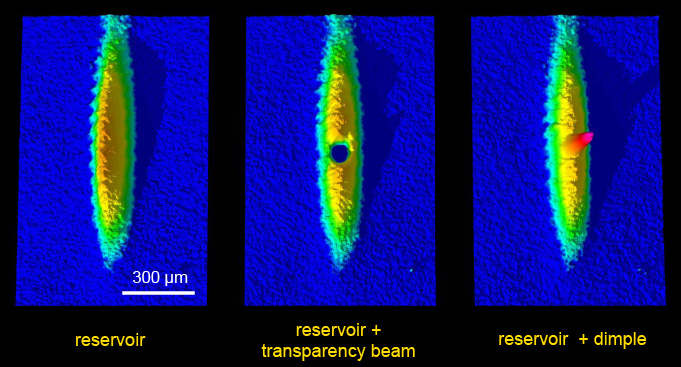A long-standing goalLaser cooling is a very elegant and versatile technique, as it allows to cool atoms, molecules, ions, and even mechanical objects from room temperature down to temperatures as low as one millionth of a degree above absolute zero. At these low temperatures, we can enter into the world of quantum mechanics. One of the fascinating phenomena associated with this ultracold regime is the appearance of quantum degeneracy in atomic gases. Would it be possible to reach quantum degeneracy by laser cooling? This question has been asked since the early days of laser cooling, but despite tremendous progress made on both theoretical and experimental sides, this goal has been elusive. A breakthrough came in the middle of the 1990’s, when evaporative cooling was applied to gases of alkali atoms, which had been pre-cooled by laser radiation. For the first time, it became possible to create Bose-Einstein condensates (BECs) in atomic gases. Evaporative cooling turned out to be a powerful cooling method, and all BEC experiments to date employ a combination of laser cooling and evaporative cooling.
A combination of different techniques leads to successIn our laboratory, we decided to revisit some of the ideas laid out in the 1980’s and 90’s on crossing the BEC phase transition with laser cooling as the only cooling mechanism, without relying on evaporative cooling. To reach this goal, we use a collection of different tricks and techniques. The most important ingredient is called “narrow line cooling”: Our experiments are performed with the alkaline-earth element strontium, which possesses a rather narrow cooling transition of only 7kHz width. Operating a magneto-optical trap (MOT) on this narrow line, we can cool a gas of strontium atoms down to temperatures of about 800nK. This is already orders of magnitude colder than conventional MOTs of alkali atoms! The second trick is a subsequent separation of our cold gas into two spatial regions: one large region, in which about 10 million atoms are trapped in a large optical dipole trap and continuously cooled by laser light, and a small region, in which about 1 million atoms are confined at a much higher density by a steep confining potential, often called a “dimple”. This is the region where the BEC will later be created. Atoms in this region are protected from the cooling light photons by the help of an extra laser beam, which we call the “transparency beam”. This beam acts like a cap of invisibility, as it modifies the energy states of the atoms in the dimple region such that they cannot absorb photons from the cooling light. This trick is very important, as the absorption of photons in the dimple region would lead to multiple scattering and light-induced collisions, which would immediately destroy the BEC. Now we have two different regions: a central dimple region, in which the BEC will form, and the outside “reservoir” region, in which atoms are gently cooled by laser light. A connection between the two regions is established through the scattering between atoms: in this way, heat can be transferred very rapidly (on timescales of a few 10ms) from the dimple into the reservoir, where the heat is dissipated. To maximize this heat transfer, we place the dimple right into the center of the reservoir, as can be seen in the figure below.
Figure 1: Three absorption images of 10 million strontium atoms trapped in a dipole trap and cooled to about 800nK by laser light. All images are taken on the narrow cooling transition. The left image shows the reservoir of atoms, which is used to dissipate heat. For the central image, we have applied the transparency beam, such that atoms located within this beam cannot absorb photons from the cooling light. The density in this region is greatly enhanced by a dimple beam, as can be seen on the right image, where the transparency beam has been turned off.
Once the system is prepared in this configuration, it takes only about 60ms for a BEC to appear, and after a little over 100ms, the BEC has reached its final size of about 100 000 atoms. This technique is not only beautiful in itself, but it can find an immediate application in an experiment to create a continuous atom laser. Here, a thermal source of atoms would be converted into a coherent beam of atoms, constantly outcoupled from the dimple region. The dimple would be continuously fed by the reservoir region, which in turn would be replenished by pre-cooled atoms from a MOT. Such truly continuous atom lasers are highly desired in various schemes of precision measurements.
Figure 2: Absorption images, taken 24ms after release from the trap. On the left image, the BEC is faintly visible as an elliptic density increase in the center. For the right image, we have removed all atoms from the reservoir just before the release from the trap, and the BEC stands out clearly.
Extension to other elementsTo our surprise, we found that our new technique is very robust against variation of all relevant parameters. We believe that it should also be possible to adapt this strategy to other elements: we expect it to work with all species that possess a narrow cooling transition and have a reasonable scattering behavior. These criteria are fulfilled by a selection of elements, most prominently the lanthanides. The range of suitable candidates can be increased substantially by going one step further: sympathetic cooling between strontium and another element. This element would not need to feature a narrow cooling transition. Instead, it would be trapped in the dimple region and sympathetically cooled through collisions with the strontium atoms in the reservoir. Such a scenario is currently investigated in our laboratory.
The TeamSimon Stellmer, Benjamin Pasquiou, Rudolf Grimm, and Florian Schreck
References
|

